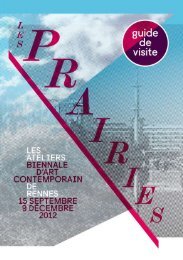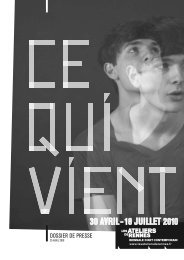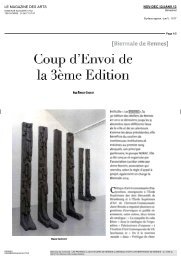Download here the Visitor's guide. - Les Ateliers de Rennes
Download here the Visitor's guide. - Les Ateliers de Rennes
Download here the Visitor's guide. - Les Ateliers de Rennes
Create successful ePaper yourself
Turn your PDF publications into a flip-book with our unique Google optimized e-Paper software.
JOCHEN LEMPERT<br />
Foraging gulls indicate <strong>the</strong> height of flying insects, 2005.<br />
Courtesy of <strong>the</strong> artist and galery ProjecteSD, Barcelona.<br />
DÓRA MAURER<br />
The principle of perpetual motion lies at <strong>the</strong> heart of<br />
Dóra Maurer's approach. Some of her works can be<br />
read in one direction or <strong>the</strong> o<strong>the</strong>r and <strong>the</strong> repetition,<br />
folding, loops or spirals involved, indicate reversal<br />
processes in line with <strong>the</strong> principles of engraving.<br />
In <strong>the</strong> late 1960s, she ad<strong>de</strong>d photography and film<br />
to her activities, both as documentary vestiges and<br />
also as autonomous sequences of basic gestures such<br />
as walking, turning <strong>the</strong> head, or shaking hands. In<br />
her film Timing (1973/1980), Maurer folds a piece of<br />
white linen that is in proportion to <strong>the</strong> dimensions<br />
of <strong>the</strong> image as well as <strong>the</strong> span of her arms. As <strong>the</strong><br />
folding proceeds, <strong>the</strong> cloth disappears to reveal a dark<br />
background. In <strong>the</strong> vi<strong>de</strong>o Proportions (1979) it is, as it<br />
were, her own body that she folds. After measuring<br />
out her own height on a strip of paper, she folds it<br />
over and divi<strong>de</strong>s it into halves and <strong>the</strong>n quarters. In<br />
a strange choreography she treads on it, rests her<br />
elbows on it, and <strong>the</strong>n kisses it. The measuring scale's<br />
abstract calibrations no longer seem to correspond<br />
to <strong>the</strong> original, nor to any hid<strong>de</strong>n yardstick. The<br />
subversive nature of this anthropometric en<strong>de</strong>avour<br />
flies in <strong>the</strong> face of standardization.<br />
H. M. tr. J. H.<br />
Born in 1937 in Budapest (Hungary) w<strong>here</strong> she lives<br />
and works.<br />
<strong>Les</strong> Prairies's artists<br />
With his background as an ornithologist on research<br />
vessels in <strong>the</strong> North Sea, Jochen Lempert brings a trained<br />
scientific eye to his photographic subjects. This does not,<br />
however, prevent him from injecting <strong>the</strong>m with a fair dose<br />
of wi<strong>de</strong>-eyed humour or melancholy. Lempert <strong>de</strong>velops<br />
his own black and white prints, which he invariably<br />
leaves unframed. Their disarming simplicity makes <strong>the</strong>m<br />
objects in <strong>the</strong>ir own right, leading him occasionally to<br />
complicate <strong>the</strong>ir status as images by making it impossible<br />
to <strong>de</strong>ci<strong>de</strong> whe<strong>the</strong>r <strong>the</strong>y are figurative or abstractions. The<br />
sheer variety of work displayed <strong>here</strong> gives us an insight<br />
into Lempert's style. Stadtstrukturen, which represents a<br />
couple of pigeons poking about in a <strong>de</strong>serted town centre,<br />
is an ironic parody of anthropomorphism. Fly shows a<br />
single fly in sharp focus against a blurred hedge. It is as<br />
if Lempert had frozen this most banal of insects in full<br />
flight in or<strong>de</strong>r to contemplate <strong>the</strong> miracle of life. Consi<strong>de</strong>r<br />
also <strong>the</strong> very recent Untitled (Hoopoe, Delhi): a single<br />
Hoopoe is escaping shyly into <strong>the</strong> grainy, grey-white that<br />
covers almost <strong>the</strong> entire surface of <strong>the</strong> photograph. The<br />
tremendous pathos of this photo comes from <strong>the</strong> bird's<br />
obvious need to get away, which seems as urgent as, in<br />
<strong>the</strong> end, it is incomprehensible.<br />
C. S. tr. J.H.<br />
Born in 1958 in Moers (Germany), lives and works in<br />
Hambourg (Germany).<br />
Proportions, 1979. Production He<strong>de</strong>ndaagse Kunst, Utrecht.<br />
Courtesy of <strong>the</strong> artist.<br />
59






